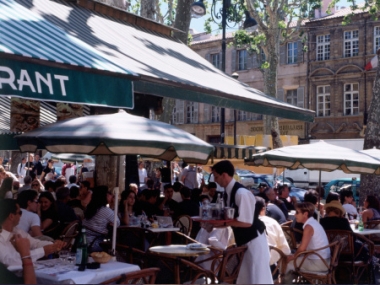Busy Sidewalks (not only for Pedestrians?)
Edited on
22 July 2015From strolling and hangout to transportation and street vending, sidewalks have had many roles in since the late 19th century. While they have been considered “the main public places of the city” and “its most vital organs”1, the division between sidewalks’ social and physical dimensions is not always obvious.

By the late nineteenth century, sidewalks were commonly constructed in London, Paris, and most other European cities. The grand boulevards that were built in Paris, Vienna and Barcelona reserved generous sidewalks for the crowds of urban flâneurs – to stroll, and hangout. Immortalized by impressionist painters, these sidewalks epitomized nineteenth-century urbanity in the public imagination.
And one use, walking for transportation, became the primary purpose for which the sidewalks were constructed. The pedestrian’s unobstructed mobility became the justification that underlay other activity restrictions, and the pedestrian became the public for whom the sidewalks were being provided. The assumption that walking is the primary use for sidewalks has carried into the twenty-first century.
Despite a legacy of positive social and political changes –activities that challenged segregation have become unremarkable a generation later- sidewalk users have an ambivalent relationship to disruptive events and people. Events that interfere with mobility and block of delay passage violate the notion of the pedestrian as the primary sidewalk user.
Sidewalks present a paradox. Many sidewalks uses have overlapping purposes, and this variety created diversity and draws people to the street. At the same time, coexisting activities can conflict with one another. Sidewalks are functional parts of the roadway but also useful to abutting spaces.
People who are dependent on street activities become the problem. Regulations must further a public purpose, but because the public is composed of groups which varying needs and interests, this concept is ambiguous.
Recent immigrants traditionally have used and are using street vending as an economic entry point. When they do so, they compete with long-standing business and invoke the wrath of the established classes who are troubled by such appropriation of public spaces.
Municipalities oppose street vending in the name of “public health”, “aesthetics”, or the public’s right to “unobstructed movement” on the sidewalks. Street vendors are frequently painted in the public imagination as “loud”, “undignified” and “undesirable”. Ordinances regulating street commerce are adopted to eliminate noise, congestion, and filth.
Municipalities agree that the pedestrian in the only legitimate sidewalk user. In other words, the pedestrian is defined as the public for which sidewalks should be provided and the goal of unobstructed pedestrian circulation justifies prohibiting other “disruptive” activities.
Vendors and their advocates contest the view that the sidewalk is a beautiful space for unobstructed and orderly pedestrian circulation that is to be protected by the security officers but they articulate it with a multipurpose vision for the sidewalks and view survival as a legitimate use.
The arguments and counterarguments point to two conflicting images for sidewalks. One image is held by a public that wants to keep sidewalks safe, clean, predictable, orderly, and aesthetically pleasant urban landscapes that connect points of origin and destination and serve as forecourts to commercial, retail, and residential establishments. This image is threatened by another image that is held by a mostly immigrant counter public that actively appropriates (through their bodies and wares) the sidewalk for trade and economic exchanges. Using historical and contemporary examples, the clash of these two images has generated disputes time and again.
On the one side the vendors defend their right to the city and its public spaces for economic activities. On the other side, established merchants and middle and upper class residents claim to be hurt by the messiness, congestion, disorder, and unfair competition imposed by street vendors.
Between the two sides but usually favoring established residents and merchants are municipal authorities that issue ordinances and regulations that impose a technical rationality on a conflict between values and cultural norms. But political struggles over the use of public spaces are rarely fully resolved by city ordinances, zoning, and nuisance regulations.
Some city policies attempts to eliminate, contain, or prohibit controversial activities. They often confuse public space as a social entity (through which people develop relationship, articulate interests, and live shared and varied lives) with the conception of public space as a physical entity (which can be controlled). City actions are as much incremental reactions as proactive attempts to purify public space. Cities need innovative approaches to integrate diverse activities and contradictory goals and continue the process of making spaces for multiple publics.
By Fernando Barreiro, Lead-expert of the USER project
Read more:
USER – URBACT network minisite
Getting Residents Involved in Improving Public Spaces: Lessons Learned – URBACT blog
1 Jane Jacobs (1961) The Death and Life of Great American Cities
 Submitted by URBACT on
Submitted by URBACT on




